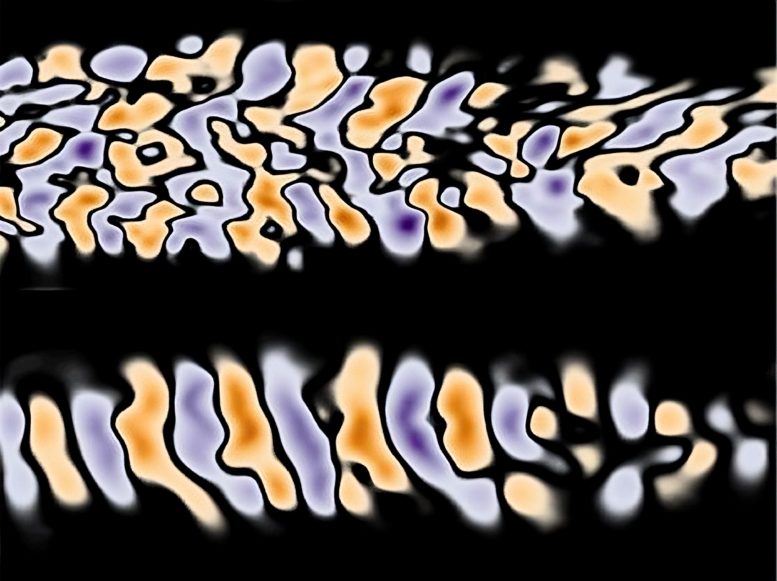
Contours of magnetic fields that emerge a result of self-organization of microscopic currents resulting from the Weibel instability in a carbon dioxide laser-produced plasma probed by an ultrashort relativistic electron beam. Credit:
Chaojie Zhang, the University of California Los Angeles
A groundbreaking experiment offers new insights into the potential mechanism that could seed magnetic fields for the galactic dynamo.
The Science
Plasma is a state of matter where the intense heat causes the separation of electrons from atoms, resulting in a mixture of free-floating electrons and ionized atoms. This ionized gas, known as plasma, constitutes the majority of the observable universe. Recent findings indicate that magnetic fields can emerge spontaneously within plasma. This occurs when there is a variation in temperature along different spatial directions, a phenomenon referred to as temperature anisotropy. This mechanism is referred to as the Weibel instability.
It was predicted by plasma theorist Eric Weibel more than six decades ago but only now has been unambiguously observed in the laboratory. The new research finds that this process can convert a significant fraction of the energy stored in the temperature anisotropy into magnetic field energy. It also finds that the Weibel instability could be a source of magnetic fields that permeate throughout the cosmos.
The Impact
The matter in our observable universe is plasma state and it is magnetized. Magnetic fields at the micro-gauss level (about a millionth of the Earth’s magnetic fields) permeate the galaxies. These magnetic fields are thought to be amplified from weak seed fields by the spiral motion of the galaxies, known as the galactic dynamo.
How the seed magnetic fields are created is a longstanding question in astrophysics. This new work offers a possible solution to this vexing problem of the origin of the microgauss level seed magnetic fields. The research used a novel platform that has great potential for studying the ultrafast dynamics of magnetic fields in the laboratory plasmas that are relevant to astro- and high-energy-density physics.
Summary
First theorized six decades ago, the Weibel instability driven by temperature anisotropy is thought to be an important mechanism for the self-magnetization of many laboratory and astrophysical plasmas. However, scientists have faced two challenges in unambiguously demonstrating the Weibel instability. First, until recently, researchers were not able to generate a plasma with a known temperature anisotropy as initially envisioned by Weibel. Second, researchers had no suitable technique to measure the complex and rapidly evolving topology of the magnetic fields subsequently generated in the plasma.
This work, enabled by the unique capability of the Accelerator Test Facility, a Department of Energy (DOE) user facility at Brookhaven National Laboratory, employed a novel experimental platform that allowed the researchers to create a hydrogen plasma with a known highly anisotropic electron velocity distributions on a tens of trillionth of a second timescale by using an ultrashort but intense carbon dioxide laser pulse.
The subsequent thermalization of the plasma occurs via self-organization of plasma currents that produces magnetic fields driven by Weibel instability. These fields are large enough to deflect relativistic electrons to reveal an image of the magnetic fields a certain distance from the plasma. The researchers obtained a movie of the evolution of these magnetic fields with exquisite spatiotemporal resolution by using an one picosecond relativistic electron beam to probe these fields.
Reference: “Mapping the self-generated magnetic fields due to thermal Weibel instability” by Chaojie Zhang, Yipeng Wu, Mitchell Sinclair, Audrey Farrell, Kenneth A. Marsh, Irina Petrushina, Navid Vafaei-Najafabadi, Apurva Gaikwad, Rotem Kupfer, Karl Kusche, Mikhail Fedurin, Igor Pogorelsky, Mikhail Polyanskiy, Chen-Kang Huang, Jianfei Hua, Wei Lu, Warren B. Mori and Chan Joshi, 5 December 2022, Proceedings of the National Academy of Sciences.
DOI: 10.1073/pnas.2211713119
The study was funded by the Department of Energy (DOE) Office of Science, the National Science Foundation, and the NSF Graduate Research Fellowships Program. The Accelerator Test Facility is supported by the DOE Office of Science. The principal investigator’s work at UCLA is supported by the National Science Foundation (NSF), the DOE Office of Science High Energy Physics program, and the NSF Graduate Research Fellowships Program.

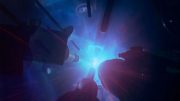
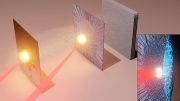
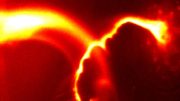
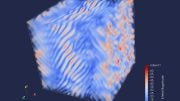
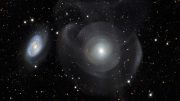
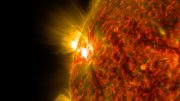
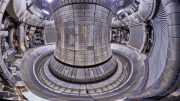
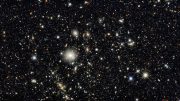
Be the first to comment on "Novel Experiment Sheds New Light on the Mechanism of Cosmic Magnetic Fields"